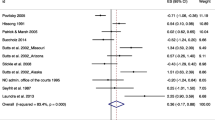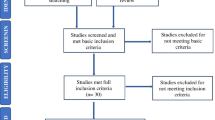Abstract
Research suggests that juvenile court dispositions are influenced by legal factors, such as offense severity and prior record, as well as extralegal factors, such as race/ethnicity, sex, and age. To date, however, no research has reviewed whether legal or extralegal factors are more predictive of juvenile court dispositions across extant research. To address this gap, the present study reports on a systematic review and meta-analysis of predictors of residential placement in the juvenile justice system. A total of 40 independent samples were analyzed from 33 studies that met the criteria for inclusion in the review. Meta-analytic techniques were used to examine the average effects of offense characteristics, prior record, age, preadjudication detention status, race and ethnicity, sex, and contextual factors on odds of placement. The findings suggest that legal factors are more strongly associated with juvenile court dispositions than extralegal or contextual factors. Additionally, the strongest predictor of placement was whether the juvenile defendant had been detained at intake, illustrating the influential role of early case assessment in juvenile court.








Similar content being viewed by others
Notes
In the broader criminal justice context, Pratt (1998) reviewed sentencing research and performed a meta-analysis of predictors of sentence length across 47 prior studies. While the main focus was on race—which appears to be the focus of most research on case-level processing in criminal as well as juvenile justice (see Mitchell, 2005; Zane & Pupo, 2021)—Pratt (1998) also ran analyses for prior record and offense severity. Neither prior record nor race were significant predictors of sentence length across studies, with weighted effect sizes of r = 0.07 and r = 0.12, respectively. Severity of offense, however, was significantly associated with sentence length—with a larger weighted effect size of r = 0.36.
It is worth noting that simply transforming the odds ratio into another metric, such a r or d, does not address the underlying issue. Moreover, “these methods are only approximations and do not necessarily provide the exact effect that would have been observed had the outcome been scaled or dichotomized” (Petersen et al., 2022, p. 10). As such, it remains common practice for meta-analysts to use the odds ratio as the summary effect metric for research questions that employ dichotomous outcomes (e.g., Lapsey et al., 2021; Petersen et al., 2022).
Fifteen studies coded female as “1” and male as “0”, and these were converted into effect sizes for male (by reversing the sign of the logged odds).
To assess whether outlier effect sizes influenced the summary effects, separate meta-analyses were conducted with each individual study removed. In no instance did the direction or significance of the summary effect change, indicating no substantial outliers.
For offense characteristics, 95% prediction intervals were as follows: felony [0.55, 8.65]; severity [0.91, 1.12]; violent-binary [0.75, 2.64]; violent-versus-property [0.73, 1.64].
For prior record, 95% prediction intervals were as follows: count adjudications [1.03, 1.86]; binary referrals [1.35, 4.85]; count referrals [1.01, 1.47].
Three studies appeared to use an ordinal measure for age and were included. Sensitivity analysis revealed that removing these studies did not change the direction or significance of the summary effect.
For age, the 95% prediction interval was [0.83, 1.28].
For detention, the 95% prediction interval was [1.62, 6.95].
For race/ethnicity, the 95% prediction intervals were as follows: Black/White [0.48, 3.08]; Hispanic/White [0.42, 2.96]; non-White/White [0.89, 1.59].
For sex, the 95% prediction interval was [0.48, 3.27].
For contextual factors, the 95% prediction intervals were as follows: concentrated disadvantage [0.80, 1.31]; racial composition [0.96, 1.05].
References
Barton, W. H. (2012). Detention. In Feld, B. C. & Bishop, D. M. (Eds.), The Oxford handbook of juvenile crime and juvenile justice (pp. 636–663). Oxford University Press.
Beaudry-Cyr, M., Leiber, M., Brubaker, S. J., & Jaynes, C. (2020). The liberation hypothesis perspective and juvenile court outcomes: Implications for an understanding of the interplay between offender and offense characteristics. Crime & Delinquency, 66(6-7), 806–836.
Berk, R. (2007). Statistical inference and meta-analysis. Journal of Experimental Criminology, 3(3), 247–270.
Bishop, D. M., & Leiber, M. J. (2010). Racial and ethnic differences in delinquency and justice system responses. In Feld, B. C. & Bishop, D. M. (Eds.), The Oxford handbook of juvenile crime and juvenile justice (pp. 445–484). Oxford University Press.
Bishop, D. M., Leiber, M. J., & Johnson, J. (2010). Contexts of decision making in the juvenile justice system: an organizational approach to understanding minority overrepresentation. Youth Violence and Juvenile Justice, 8(3), 213–233.
Borenstein, M., Hedges, L. V., Higgins, J. P. T., & Rothstein, H. R. (2009). Introduction to meta-analysis. John Wiley and Sons, Ltd.
Bouchard, J., & Wong, J. S. (2017). A jury of their peers: a meta-analysis of the effects of teen court on criminal recidivism. Journal of Youth and Adolescence, 46(7), 1472–1487.
Bridges, G. S., & Steen, S. (1998). Racial disparities in official assessments of juvenile offenders: Attributional stereotypes as mediating mechanisms. American Sociological Review, 63(4), 554–570.
Cauffman, E., Piquero, A. R., Kimonis, E., Steinberg, L., Chassin, L., & Fagan, J. (2007). Legal, individual, and environmental predictors of court disposition in a sample of serious adolescent offenders. Law and Human Behavior, 31(6), 519–535.
Cohen, L. E., & Kluegel, J. R. (1978). Determinants of juvenile court dispositions: Ascriptive and achieved factors in two metropolitan courts. American Sociological Review, 43(2), 162–176.
Elwert, F., & Winship, C. (2014). Endogenous selection bias: The problem of conditioning on a collider variable. Annual Review of Sociology, 40, 31–53.
Evans, D. N., Moreno, G., Wolff, K. T., & Butts, J. A. (2020). Easily overstated: Estimating the relationship between state justice policy environments and falling rates of youth confinement. Final report of research project 2017-JFFX-0064, U.S. Department of Justice. New York, NY: Research and Evaluation Center, John Jay College of Criminal Justice, City University of New York.
Feld, B. C. (1991). Justice by geography: Urban, suburban, and rural variations in juvenile justice administration. Journal of Criminal Law & Criminology, 82(1), 156–210.
Feld, B. C. (1993). Criminalizing the American juvenile court. Crime and Justice, 17, 197–280.
Feld, B. C. (2017). The evolution of the juvenile court: Race, politics, and the criminalizing of juvenile justice. New York University Press.
Feyerherm, W. H., & Pope, C. E. (1982). Legal, extra-legal, and organizational factors in the disposition of juveniles. International Journal of Comparative and Applied Criminal Justice, 6(1-2), 117–123.
Hockenberry, S., & Puzzanchera, C. (2021). Juvenile court statistics, 2019. National Center for Juvenile Justice.
Horwitz, A., & Wasserman, M. (1980). Formal rationality, substantive justice, and discrimination. Law and Human Behavior, 4(1), 103–115.
IntHout, J., Ioannidis, J. P., Rovers, M. M., & Goeman, J. J. (2016). Plea for routinely presenting prediction intervals in meta-analysis. BMJ Open, 6(7), 1–6.
Kowalski, G. S., & Rickiki, J. P. (1982). Determinants of juvenile postadjudication dispositions. Journal of Research in Crime and Delinquency, 19(1), 66–83.
Kurlychek, M. C., & Johnson, B. D. (2019). Cumulative disadvantage in the American criminal justice system. Annual Review of Criminology, 2, 291–319.
Lapsey Jr., D. S., Campbell, B. A., & Plumlee, B. T. (2021). Focal concerns and police decision making in sexual assault cases: a systematic review and meta-analysis. Trauma, Violence, & Abuse. Advanced online publication. https://doi.org/10.1177/1524838021991285.
López-López, J. A., Page, M. J., Lipsey, M. W., & Higgins, J. P. T. (2018). Dealing with effect size multiplicity in systematic reviews and meta-analyses. Research Synthesis Methods, 9(3), 336–351.
Mears, D. P., Cochran, J. C., Stults, B. J., Greenman, S. J., Bhati, A. S., & Greenwald, M. A. (2014). The “true” juvenile offender: age effects and juvenile court sanctioning. Criminology, 52(2), 169–194.
Mitchell, O. (2005). A meta-analysis of race and sentencing research: explaining the inconsistencies. Journal of Quantitative Criminology, 21(4), 439–466.
Norton, E. C., & Dowd, B. E. (2018). Log odds and the interpretation of logit models. Health Services Research, 53(2), 859–878.
Oliver, J., & Bell, M. L. (2013). Effect sizes for 2 x 2 contingency tables. PLoS One, 8(3), 1–7.
Petersen, K., Davis, R. C., Weisburd, D., & Taylor, B. (2022). Effects of second responder programs on repeat incidents of family abuse: an updated systematic review and meta‐analysis. Campbell Systematic Reviews, 18(1), e1217.
Pratt, T. C. (1998). Race and sentencing: a meta-analysis of conflicting empirical research results. Journal of Criminal Justice, 26(6), 513–523.
Reitler, A. K., Sullivan, C. J., & Frank, J. (2013). The effects of legal and extralegal factors on detention decisions in US district courts. Justice Quarterly, 30(2), 340–368.
Sampson, R. J., & Laub, J. H. (1993). Structural variations in juvenile court processing: inequality, the underclass, and social control. Law & Society Review, 27(2), 285–311.
Tanenhaus, D. S. (2010). The elusive juvenile court: Its origins, practices, and re-inventions. In Feld, B. C. & Bishop, D. M. (Eds.), The Oxford handbook of juvenile crime and juvenile justice (pp. 419–444). Oxford University Press.
Turanovic, J. J., & Pratt, T. C. (2021). Meta-analysis in criminology and criminal justice: challenging the paradigm and charting a new path forward. Justice Evaluation Journal, 4(1), 21–47.
Wilson, D. B. (2010). Meta-analysis. In A. R. Piquero & D. Weisburd (Eds.), Handbook of quantitative criminology (pp. 181–208). Springer.
Yeaton, W. H., & Wortman, P. M. (1993). On the reliability of meta-analytic reviews: the role of intercoder agreement. Evaluation Review, 17(3), 292–309.
Zane, S. N. (2022). Explaining variation in juvenile punishment: The role of communities and systems. Routledge.
Zane, S. N. (2021). Have racial and ethnic disparities in juvenile justice reduced over time? An empirical assessment of the DMC mandate. Youth Violence and Juvenile Justice, 19(2), 163–185.
Zane, S. N., & Pupo, J. A. (2021). Disproportionate minority contact in the juvenile justice system: a systematic review and meta-analysis. Justice Quarterly, 38(7), 1293–1318.
Acknowledgements
The authors would like to thank the Editor and the anonymous reviewers for their valuable feedback and suggestions on an earlier version of this manuscript.
Authors' Contribution
S.Z. conceived of the study, participated in its design and coordination, performed the statistical analyses and interpretation of data, and drafted the manuscript; J.P. participated in the study design and coordination, performed data collection, and helped draft the manuscript. All authors read and approved the final manuscript.
Data Sharing Declaration
The datasets generalized and analyzed during the current study are not publicly available but are available from the corresponding author on reasonable request.
Author information
Authors and Affiliations
Corresponding author
Ethics declarations
Conflict of Interest
The authors declare no competing interests.
Additional information
Publisher’s note Springer Nature remains neutral with regard to jurisdictional claims in published maps and institutional affiliations.
Supplementary Information
Rights and permissions
Springer Nature or its licensor holds exclusive rights to this article under a publishing agreement with the author(s) or other rightsholder(s); author self-archiving of the accepted manuscript version of this article is solely governed by the terms of such publishing agreement and applicable law.
About this article
Cite this article
Zane, S.N., Pupo, J.A. What Predicts Out-of-Home Placement in Juvenile Court Dispositions? A Systematic Review and Meta-Analysis. J Youth Adolescence 52, 229–244 (2023). https://doi.org/10.1007/s10964-022-01686-2
Received:
Accepted:
Published:
Issue Date:
DOI: https://doi.org/10.1007/s10964-022-01686-2




